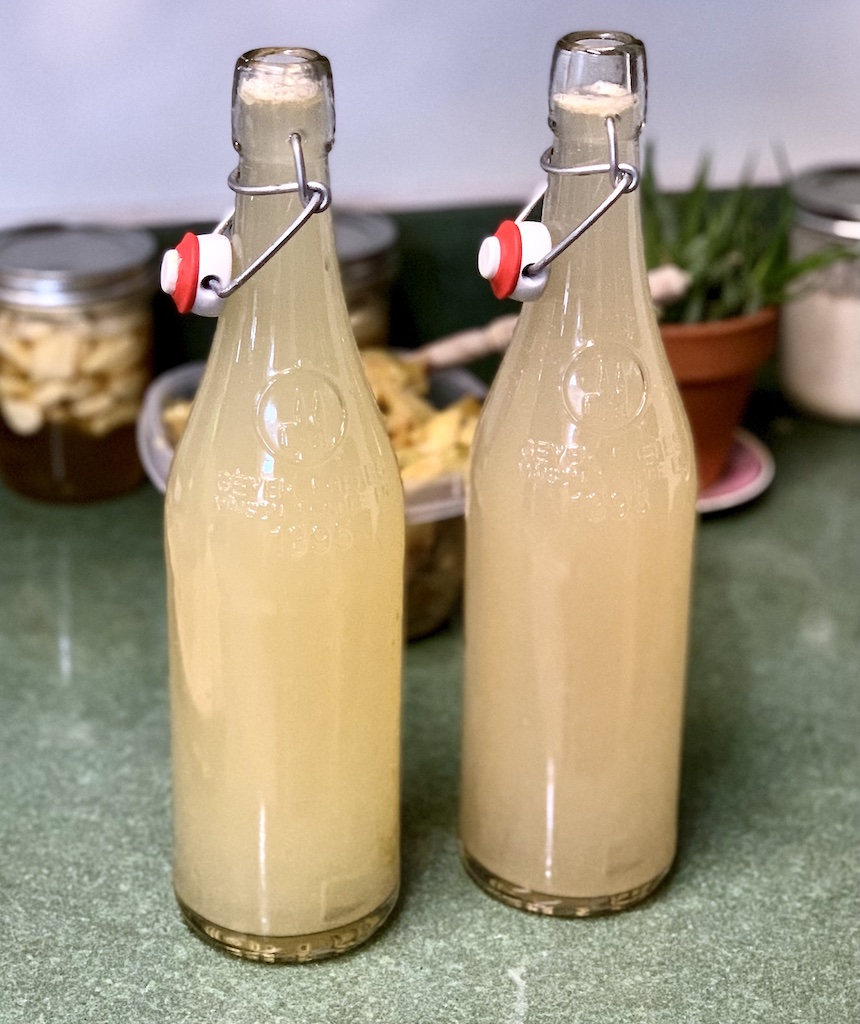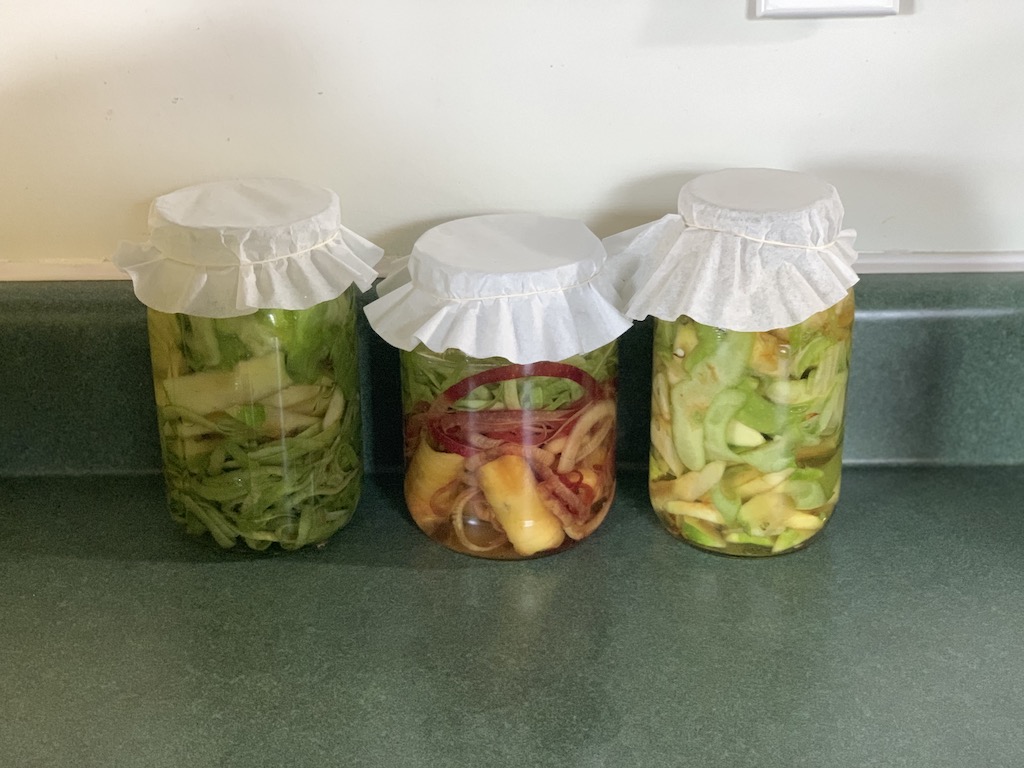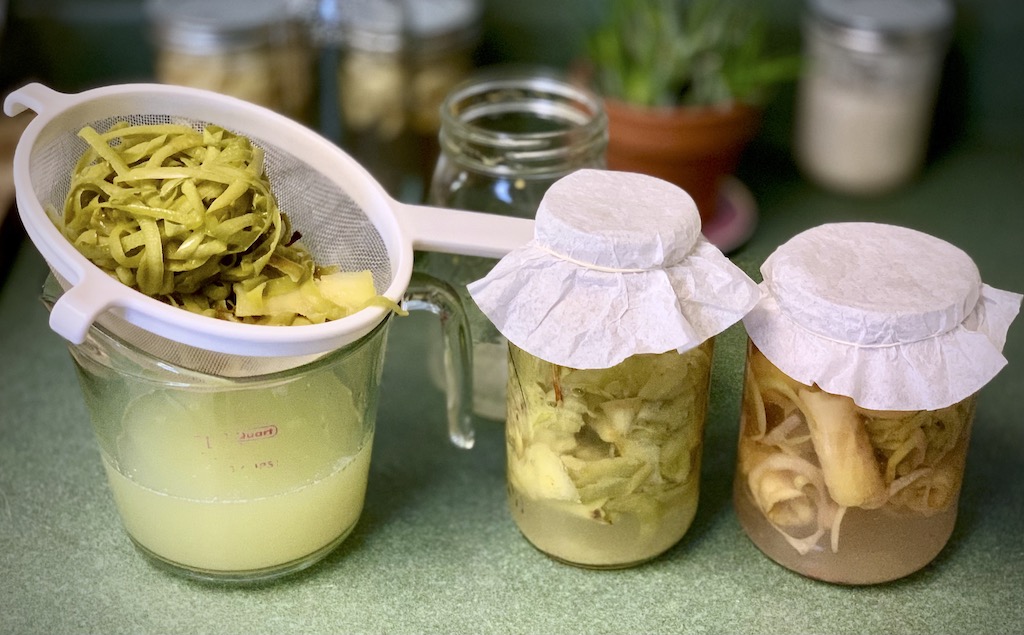Learn how to make healthy, organic, homemade Apple Cider Vinegar from apple scraps in my easy, do it yourself tutorial. Making homemade Apple Cider vinegar is easy and almost free.

Lately, here in Tennessee, the weather has been dreary, rainy, and cold. Fall is in the air. Though my husband doesn’t realize this, Apples are a fall crop. Which is no doubt the reason he had a craving for my warm and comforting Classic Apple Pie. He had been asking me to make one for several weeks, so when I found out my neighbors birthday was the day before, I got the motivation I needed and went to work making two, one for them and one for us.
Homemade Organic Apple Cider Vinegar as a byproduct
When making Apple Pie you don’t leave the peels on the apples and for the last year I have been trying to move closer to a zero waste home. Usually that means we compost everything that does end up going bad or we give it to our animals. However, if I can find another use for something before it makes it to the compost bin, Im on board. Making Homemade Organic Apple Cider Vinegar is a great secondary way to use the scraps, making the vinegar into a byproduct of the Apple Pies.
I also plan to make more Apple Cider Vinegar when I can my Organic Apple Pie Filling
This post contains affiliate links, which means I make a small commission at no extra cost to you. See my full disclosure here
What you will need
- Wide mouth Mason Jars, or empty pickle jars
- Apple Scraps
- Organic Cane Sugar
- Distilled Water- you don’t want any residual chemicals in the water, chlorine will work against us here.
- Apple peeler– This is my all time new favorite kitchen gadget right now
- Coffee Filters
- Rubberbands
- a Spoon
First Thing First
Though making homemade organic Apple Cider Vinegar is a pretty easy and straightforward process, there are a few preparation tips that need to be talked about first.
- When Fermenting food you want pesticide free foods. Buying Organic Apples is so important. Apples are near the top of the dirty dozen list of foods to buy organic because of the high number of pesticides found on them and some are in very high concentrations. Washing may help but pesticides are absorbed into the fruit while they grow so it is recommended that you buy organic. Pesticides also impede the microorganisms needed for the fermentation process and the pesticides can actually go through a chemical change during fermentation and produce even more harmful chemicals.
- Wash your fruit. Ironically I soak all my fruit in a bowl of water with 1/4 cup of Apple Cider Vinegar and a drop of dish soap.
- Im a big fan of using a crank apple peeler. It makes the job of peeling a 16 apples so much easier and the kids love to use the spiral setting for their afternoon snack. In general I try not to buy one use kitchen gadgets but this one is worth it.
- Wide mouth mason jars make the job of loading easier, they provide a larger surface area for oxygen to get into the ferment and for ease of cleaning afterwards.
Making the Homemade Organic Apple Cider Vinegar
This is the easy part. Gather your peels and cores, stems and seeds are fine as well, no need to sort through anything here. Fill a quart sized mason jar to about 2/3 full with your scraps. You want plenty of room at the top for the scraps to float and be stirred down during this process. I made the mistake of filling my jars too full and had the Vinegar all over my counter the first time I went to go stir it.
In a separate bowl, mix two cups of distilled water with one tablespoon of organic cane sugar till dissolved. Pour this over your scraps and viola you have just started your first batch of Homemade Organic Apple Cider Vinegar! Great Job!
Next cover your jars to keep gnats or flies or any other bugs out. In this instance I used some coffee filters I had on hand from an art project and rubber bands to keep them in place. You could also use some organic bread towels. What ever you use, it needs to be pretty thin so oxygen can easily pass through. Just make sure the weave is also thick enough that pesky gnats can’t get through.
What is Fermentation?
Fermentation is basically when good microorganisms break down sugars and alcohols in foods, changing the foods in a determined desirable way. Sometimes the fermentation is to preserve the foods, adding health benefits, such as bioavailability of nutrients or good gut building bacterias, and sometimes its just to improve the flavor.

How long does it take?
Different foods ferment at different rates. Homemade Apple Cider Vinegar goes through two different fermentation processes. First the yeasts from your environment begin to colonize and eat the sugars and starches in both the peals and fruit, and in the added sugars. This process is called Lactic Acid Fermentations.
The byproduct of the bacteria eating the sugars is the production of Alcohols. The Alcohols are then eaten by bacteria and turned into vinegar. This process is called Acetic Acid Fermentation.
Once this process has taken place and all the sugars have been eaten by the yeast and the Alcohol has been eaten by the bacteria you are left with an incredibly fresh aromatic Homemade Organic Apple Cider Vinegar. This process can take around 2 weeks. Around one week it will already start to smell like vinegar.
Taking care of your Homemade Organic Apple Cider Vinegar brew
During the fermentation process the scraps will continually float to the top of the liquid. You can weigh them down by placing a baggie filled with smooth stones on top, I would double bag it. This will help keep your scraps under the liquid. I have fermentation weights like these but I used the bag of stones for years. You need to stir your scraps once a day.
If you don’t weigh the scraps down you will need to push them down and stir them once a day. I like to vigorously stir, without making a mess, to incorporate oxygen into my brew. The oxygen is needed for the Aerobic Bacteria that produces Acetic Acid Fermentation.
Also during this time you may see some white or grayish scum accumulate on top. This is yeast and you can scrape it off. It will not hurt anything.
Strain your vinegar
After the two weeks are up its time to strain your Vinegar. I use a nylon strainer because I read somewhere a long time ago that metal was bad for the microbes in fermentation products. However, I have used a metal strainer in a pinch and not noticed any harm done. If it’s what you have, I would say just use it. Unless you just want the nylon ones…

And there you have it. Your very own Organic Apple Cider Vinegar that cost you practically nothing to make. The uses are practically endless but some of my favorite ways are in homemade salad dressings, cleaning your next batch of apples or grapes, or to make a homemade sore throat tonic like the one I grew up on. I also use lots of vinegar while cleaning because harsh chemicals hurt my throat and make me sick the next day.


Leave a Reply